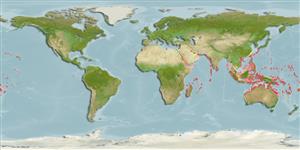>
Acanthuriformes (Surgeonfishes) >
Acanthuridae (Surgeonfishes, tangs, unicornfishes) > Acanthurinae
Etymology: Acanthurus: Greek, akantha = thorn + Greek, oura = tail (Ref. 45335).
Eponymy: Marcus Élieser Bloch (1723–1799) was a German physician and naturalist specialising in ichthyology. [...] (Ref. 128868), visit book page.
More on author: Valenciennes.
Environment: milieu / climate zone / depth range / distribution range
Ecologia
marinhas associadas(os) a recifes; intervalo de profundidade 2 - 15 m (Ref. 90102). Tropical; 31°N - 34°S, 25°E - 156°W
Indo-Pacific: East Africa, including the Mascarene Islands (Ref. 37792) to the Hawaiian and Society islands, north to Ryukyu Islands, south to Lord Howe Island.
Tamanho / Peso / Idade
Maturity: Lm ? range ? - ? cm
Max length : 45.0 cm SL macho/indeterminado; (Ref. 48637); idade máx. registrada: 35 anos (Ref. 52229)
Espinhos dorsais (total) : 9; Raios dorsais (total) : 25 - 27; Espinhos anais: 3; Raios anais : 24 - 25. Color in life bluish grey with numerous yellowish brown spots which tend to form irregular longitudinal lines; head with narrow irregular stripes; behind eye a yellow spot; brown pectoral fins; base of caudal fin with white bar. Caudal spine large, 3 - 4.4 in head. Stomach gizzard-like. Differs from A. dussumieri by having vertical stripes instead of spots on the blue central area of the caudal fin, from A. mata by having a lunate caudal fin, and from A. xanthopterus by having plain brown to blue-grey pectoral fins (Ref. 1602). The white ring around the base of the tail varies in intensity and may occasionally be absent (Ref. 1602).
Adults occur in outer lagoon and seaward reefs, usually seen in small groups and school in some oceanic locations (Ref. 48637). Benthopelagic (Ref. 58302). They feed primarily on the algal film covering compacted sand, ingesting the usual component of sand which probably aids in the trituration of the algal food in the thick-walled stomach, also feed on diatoms and detritus (Ref. 3921).
Ciclo de vida ou comportamento de acasalamento
Maturidade | Reprodução | Desova | Ovos | Fecundidade | Larvas
Randall, J.E., 1987. Three nomenclatorial changes in Indo-Pacific surgeonfishes (Acanthurinae). Pac. Sci. 41(1-4):54-61. (Ref. 1921)
Status na Lista Vermelha da UICN (Ref. 130435: Version 2024-2)
Ameaça para os humanos
Harmless
Uso pelos humanos
Pescarias: espécies comerciais; Aquário: Espécies comerciais
Ferramentas
Relatórios especiais
Baixar XML
Fontes da internet
Estimates based on models
Preferred temperature (Ref.
123201): 24.9 - 28.8, mean 27.8 °C (based on 1800 cells).
Índice de diversidade filogenética (Ref.
82804): PD
50 = 0.5000 [Uniqueness, from 0.5 = low to 2.0 = high].
Bayesian length-weight: a=0.02089 (0.01363 - 0.03203), b=2.99 (2.87 - 3.11), in cm total length, based on LWR estimates for this species & Genus-body shape (Ref.
93245).
Nível Trófico (Ref.
69278): 2.0 ±0.00 se; based on food items.
Generation time: 4.4 ( na - na) years. Estimated as median ln(3)/K based on 1
growth studies.
Resiliência (Ref.
120179): Baixo, tempo mínimo de duplicação da população 4,5 - 14 anos (tmax=35; K=0.25).
Fishing Vulnerability (Ref.
59153): Moderate vulnerability (38 of 100).
Nutrients (Ref.
124155): Calcium = 47.6 [20.1, 143.2] mg/100g; Iron = 0.664 [0.254, 1.601] mg/100g; Protein = 18.2 [16.9, 19.5] %; Omega3 = 0.0856 [, ] g/100g; Selenium = 15.5 [5.3, 43.3] μg/100g; VitaminA = 40.4 [9.0, 161.5] μg/100g; Zinc = 2.73 [0.85, 5.09] mg/100g (wet weight);
